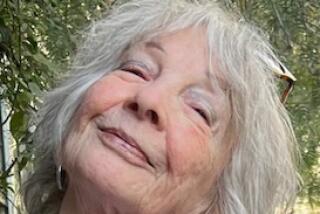Marian Gibbons dies at 89; co-founder of Hollywood Heritage
- Share via
As Hollywood preservationist Marian Gibbons saw it, “There are two Hollywoods — the geographic and the fantasy.”
“The future of geographic Hollywood,” she said in 1980, “hinges on the Boulevard, cleaning it and getting in commercial developments. The fantasy? Well, the tourists come here looking for it, something to remind them of what they think Hollywood was. … Salesmanship or P.R. won’t do it. They have to have something to see.”
Gibbons, who co-founded Hollywood Heritage in 1980 and served as the nonprofit organization’s founding president, remained committed to ensuring that as much of old Hollywood that was worth saving would be preserved for both visitors and Angelenos.
Gibbons, 89, who retired from the board of Hollywood Heritage this year because of health issues, died of lung cancer Wednesday at her home in Studio City, said Richard Adkins, the organization’s current president.
She took “preservation in Hollywood from an idea to a position where we actually became responsible for the restoration and preservation of landmarks,” said Adkins.
That included refurbishing the Lasky-DeMille Barn, where director Cecil B. DeMille set up his office and shot scenes for the 1914 film “The Squaw Man,” the first feature-length movie made in Hollywood.
The barn now sits across from the entrance to the Hollywood Bowl and houses the Hollywood Heritage Museum.
The organization also restored the historic Wattles Mansion, worked to have Hollywood Boulevard from La Brea Avenue to Argyle Avenue designated as a National Register District, and was instrumental in the restoration of the landmark Pilgrimage Cross at Cahuenga Pass.
Hollywood Heritage also facilitated the preservation of the more than 100-year-old Janes House on Hollywood Boulevard.
And working with the Los Angeles Conservancy, it saved the hat portion of the demolished Brown Derby restaurant on Wilshire Boulevard.
Gibbons viewed herself as a realist who believed that some things can be saved and some aren’t worth it.
“The thing to do is to save the important buildings, things culturally and historically important to Hollywood,” she told The Times in 1980.
Gibbons remembered being captivated by Hollywood in 1949 when she and her husband, James J. Gibbons, lived in North Hollywood for about a year and “a car trip to Hollywood was a gala event.”
“This was a beautiful city then and a wonderful place to shop,” she wrote in “Hooray for Hollywood,” a 2006 book she wrote with James C. Simmons.
Tinseltown was markedly different when she moved back to California in the late ‘70s and bought a house in the Hollywood Hills.
“Hollywood had fallen into a sorry state of decline, with an unsavory reputation for flagrant prostitution, blatant drug dealing and serious crime,” she wrote. “All the glamour and excitement of former years seemed to have left.”
A number of landmark buildings already had been lost to developers.
“Few people knew or cared about the historic buildings of Hollywood, those relics from the golden age of filmmaking,” Gibbons wrote.
It was a shame, she felt, that world-famous Hollywood did not have a preservation society.
After volunteering to help with the Hollywood Revitalization Committee founded by Councilwoman Peggy Stevenson, Gibbons met the four other women who would co-found Hollywood Heritage: Christy Johnson McAvoy, Fran Offenhauser, Mildred Heredeen and Susan Peterson.
“At that time, the going thought was that Hollywood in the 21st century would mean bulldozing the existing Hollywood and replacing it with steel skyscrapers,” recalled Offenhauser. “So it took five ladies from elsewhere who came to Hollywood and recognized that there was a tremendous national treasure in Hollywood.”
Gibbons, Offenhauser said, “was the one with the flair.”
“Marian got out front, she collared politicians, she collared business people, she brought people who weren’t necessarily the natural friends of historic preservation into the fold,” said Offenhauser. “She was the consummate public relations person and really became the face of historic preservation in Hollywood.”
Gibbons was born Sept. 29, 1921, in Akron, Ohio, and grew up in Cuyahoga Falls, Ohio. After graduating from high school in 1939, she attended a secretarial school in Akron. She married in 1941, worked at the Goodyear plant in Akron and helped build blimps during World War II.
After about a year living in North Hollywood, she and her husband moved to Elm Grove, Wis., where they owned a number of companies, including a manufacturers’ representative organization.
They later lived in Phoenix for a few years and divorced in 1978, the year Marian Gibbons bought a house in the Hollywood Hills.
The two remarried in the late ‘90s. He preceded her in death, as did their children James L. Gibbons and Jane Gibbons Knopf.
She is survived by three grandchildren.
A memorial service for Gibbons will be held at 1 p.m. Dec. 29 at the Hollywood Heritage Museum, 2100 N. Highland Ave., Hollywood.
More to Read
Start your day right
Sign up for Essential California for the L.A. Times biggest news, features and recommendations in your inbox six days a week.
You may occasionally receive promotional content from the Los Angeles Times.






